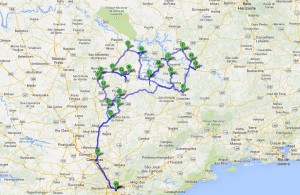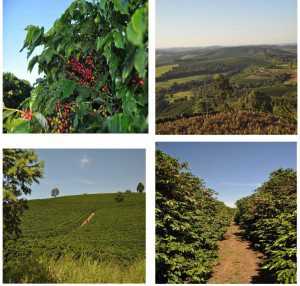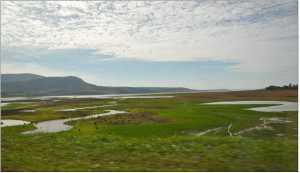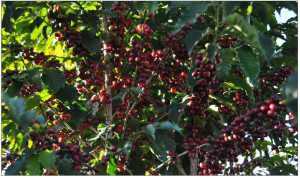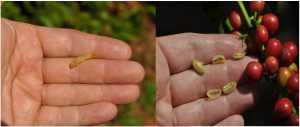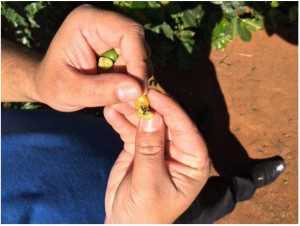In late February, Albert Scalla, INTL FCStone Senior Vice President and Tiago Ferreira, Risk Management Consultant, INTL FCStone DTVM Ltda. Made their first exclusive observations on the Brazil coffee crop, based on a 12-day trip throughout the areas of Cerrado, Alta Mogiana, Southern Minas and Southeastern Minas.
From April 28th-May 5th, they returned for a second trip, spanning 1,800 kilometers, and below provide updated information and photographs (Click on the pictures to enlarge them).
During our previous trip in mid to late February, describing the “visible” damages the drought had done to the trees along with the fungal and insect infestation, in retrospect, was easy to identify. This time around, the visual effects on the plantations and especially on the harvest were much more difficult to differentiate and easy to confuse with seemingly healthy-appearing plantations.
If you looked at the fields on this recent trip, you would notice the plants had “greened” up. They looked much better from afar and had a good deal of cherries on the trees. Surrounding non coffee areas were also quite green; not what you would consider typical of a drought situation.
However, the Brazil drought has been severe and not just in coffee. The government and local authorities are very concerned with low levels of rainfall across the nation, with cities in Minas Gerais, the main Arabica producing state, declaring a state of emergency due to the drought. Water rationing will likely be in effect soon, along with fines for violating such rationing. All of the water reservoirs of the area were quite low or in several instances, dry.
January through March are supposed to be months of heavy rainfall, periods during which the bean formation and new plant growth, for the next flowering, needs to take place.
- January should have been a month of over 360 millimeters (mm) of rain; less than 60mm was received.
- February should have been a month of over 340mm; less than 70 mm was received.
- March has an average of 220mm; about half of that was received. April, on the other hand, is typically the month where rainfall begins to subside and the actual dry period begins for the coffee areas. Average rainfall should be at about 70 to 90 mm for the month.
- April rainfall came in at approximately 100 to 110 mm.
April-May is the start of the normal dry season. This will usually last until September. The dry season does not mean that there is no rain, just heavily reduced amounts from the yearly averages.
The limited rainfall period during the dry season generates the needed stress the plants need for the flowering period once the rains return during the September 15th to October 15th period.
According to the International Coffee Organization (ICO), for the successful production of Arabica coffee, “Rainy and dry seasons must be well defined. These conditions result in one coffee growing season and one maturation season, usually in the coldest part of autumn. “
We are on our way to seeing two extended dry periods this year.
The rains received in April have certainly helped the plants recover foliage and consequently, they have “greened up.”
Cherries on the trees have ripened, albeit 30 days ahead of schedule. This is due mostly to the effects of the extended dry period, which started during the last 10 days of December and continued into April.
Plants, in their quest for survival, will accelerate ripening and let the fruit go first. As a result, farmers have begun to harvest anywhere from 20 to 40 days ahead of schedule. Arabica harvest will usually take place towards the middle to the end of May. This year, we heard of harvesting as early as the beginning of April.
Projections and Estimates
At this stage the reality can only be ascertained as yields commence to be reported. Huge differences in numbers are being reported from different areas, as well as market participants, which makes crop loss estimates and actual crop forecasts a difficult one for 2014-2015.
The younger plantations are by far the ones that have suffered the most. This is due to shallower root system in comparison with the more adult plants. Several exporters and coops we visited reported yield drops of 40 to 50% in the younger plants as the initial pickings are coming in.
Older plants, with a deeper root system, are showing initial yields drops of anywhere from 12 to 20%.
In the farms, producers are reporting large production yield drops in the initial harvest flow. Producers normally need approximately 7 measurements, 60 liters of cherries per measurement (Medidas) to complete a 60-kg bag.
Early picking indicates the use of up to 20 measurements to fill a 60-kg bag of green beans. In the younger plants, where normally approximately 620 liters of cherries are needed for a 60-kg bag, producers are seeing this need rise to 900-1,100 liters. Some extreme situations have reported upwards of 1,200 to 1,400 liters.
Harvests from older plants have shown 660 liters to 680 liters for a 60-kg bag, where normal numbers during the initial harvest periods should be running at about 520 liters.
Usually, during the beginning of the harvest, it is normal to see higher cherry inputs per 60-kg bag of output. As the harvest gets further under way, the numbers usually improve, with less cherry liters per 60-kg bag.
This year, those requirements have seen tremendous increases so far. We will need to be constantly monitoring those yields as we get further into the harvest.
All participants, from producers to coops to exporters, are having a difficult time estimating actual damages and expected harvest size.
The primary reason for this is because this is the first time that Brazil has experienced this type of extended and severe drought during the January to March months, especially with the severe temperatures that were registered during those months, not only during the days, but also during the evenings hours.
According to a survey by the Brazil-based Energy Research Company (EPE), electrical consumption in Brazil the first quarter grew by 6%, mainly driven by home demand because of the higher temperatures. Air conditioning sales also grew to record levels during this period.
The problem that we are seeing is that even if the condition of the plants look much better and they appear full of ripening fruit, looks can be misleading. Trees can be full of ripening cherries, and as we have said during our trip, “it looks like a good cherry crop.”
However, once we break the cherries open, we find an exceedingly large number of malformed beans, empty cherries, weak and flat beans.
On several of the farms, we took random samples of cherries coming in from the fields and quickly performed a buoyancy test. In the picture below, you can see two bunches of cherries; the lower bunch are the floaters (partially empty beans), while the top bunch were the ones that sank. Just by a quick glance you can see that over 60% of the cherries floated.
You can also see a large amount of dried beans on the trees and fallen beans on the ground.
Leftover effects from the drought are still present on the trees as well such as Leaf Miner damage and especially Broca (Borer Warm), diseases and pests that damage the coffee tree.
Based on the most recent observations, CoffeeNetwork has revised their estimates to losses to between 8 million and 10 million bags. Based on this, the following information can be assessed:








